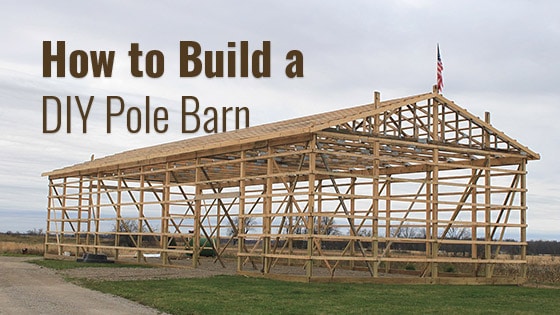
The allure of a well-constructed pole barn transcends its practicality. It embodies a unique blend of functionality and versatility, offering a customizable space that can seamlessly transform into a workshop, garage, recreational haven, or even a comfortable living space. This guide delves into the intricate process of building your own pole barn, empowering you to craft a structure that perfectly meets your needs and aspirations.
Planning and Preparation: Laying the Foundation for Success
The success of your pole barn hinges on a meticulously planned foundation. Before embarking on this construction journey, consider these key aspects:
Purpose and Design: Clearly define the purpose of your pole barn. Will it serve as a workshop, storage facility, or perhaps a multi-purpose space for family gatherings? This will dictate the necessary size, layout, and features.
Local Regulations: Familiarize yourself with building codes and zoning regulations in your area. Secure the necessary permits and ensure your design adheres to local standards.
Site Selection: Choose a level and well-drained site for your pole barn. Consider the proximity to utilities, access roads, and any potential environmental concerns.
Materials and Budget: Research and compare different materials for the poles, roof, siding, and other components. Establish a realistic budget, factoring in the cost of materials, labor, and potential contingencies.
Laying the Foundation: A Solid Base for Your Structure
A robust foundation forms the bedrock of any successful pole barn. Explore these foundation types:
Concrete Piers: These are cost-effective and suitable for lighter structures. Concrete piers are poured into pre-dug holes and then topped with anchor plates for the poles.
Concrete Slab: For heavier structures and those requiring a more finished floor, a concrete slab provides excellent stability and durability.
Footing and Wall System: This system involves excavating trenches, pouring concrete footings, and constructing a wall using concrete blocks or poured concrete. It offers exceptional strength and can accommodate a wide range of loads.
Raising the Poles: The Skeleton of Your Structure
The pole barn's signature characteristic lies in its upright poles, providing both structural integrity and a rustic aesthetic. Here's a step-by-step guide to pole erection:
1. Preparing the Poles: Ensure the poles are properly treated and sized according to the structural requirements.
2. Setting the Poles: Using a plumb bob and level, accurately position the poles on the foundation. Anchor them securely using the pre-installed anchor plates or brackets.
3. Connecting the Poles: Once all poles are erected, use heavy-duty brackets or bolts to connect them horizontally, creating a rigid frame.
4. Roof Framing: Install roof trusses or rafters onto the poles, ensuring proper spacing and alignment.
Roofing and Siding: Covering and Enclosing Your Space
The roofing and siding of your pole barn play a crucial role in its aesthetics and weather resistance. Consider these options:
Roofing: Metal roofing provides durability, longevity, and ease of maintenance. You can also opt for asphalt shingles for a more traditional look.
Siding: Metal siding offers durability and low maintenance, while wood siding provides a classic aesthetic. Consider using composite siding for a blend of both durability and visual appeal.
Windows and Doors: Letting in the Light and Access
Windows and doors are essential for creating a welcoming and functional space.
Windows: Choose strategically placed windows to maximize natural light and ventilation. Consider energy-efficient options to reduce heating and cooling costs.
Doors: Select doors that meet your specific needs, whether you require a large overhead door for vehicle access or a standard door for pedestrian entry.
Interior Finishes: Personalizing Your Space
Once the structure is complete, focus on creating a comfortable and functional interior.
Flooring: Choose flooring that suits your needs and aesthetic preferences. Options include concrete, wood, or even epoxy coatings.
Insulation and Heating/Cooling: If you plan to use the pole barn year-round, consider installing insulation and a suitable heating and cooling system.
Electrical and Plumbing: Install electrical wiring, lighting, and plumbing according to local codes and your intended use.
Final Touches: Adding a Personal Flair
Painting: Paint your pole barn in colors that complement your surroundings and personal style.
Outdoor Features: Add a porch, patio, or landscaping to enhance the overall appeal of your structure.
DIY vs. Professional Help:
While building a pole barn yourself offers a sense of accomplishment and cost savings, it requires significant time, effort, and technical expertise. If you lack experience or confidence, consider hiring a professional contractor to assist you with certain aspects of the project.
Building a Versatile Multi-Purpose Space
The beauty of a pole barn lies in its adaptability. Here are some ideas for maximizing its versatility:
Workshop/Garage: Ideal for hobbyists, mechanics, and those requiring a dedicated workspace.
Storage: Provides ample space for storing vehicles, tools, equipment, or seasonal items.
Recreational Space: Transform it into a game room, gym, or entertainment area.
Guest House/Living Space: With proper insulation and utilities, a pole barn can serve as a comfortable living space for guests or even as an additional dwelling.
Conclusion:
Building a DIY pole barn is a rewarding endeavor that allows you to create a versatile space that suits your individual needs and aspirations. By carefully planning, researching, and executing each step, you can craft a structure that serves as a practical sanctuary for years to come. Remember, the journey is as fulfilling as the final outcome, so enjoy the process and create a space that you'll cherish for a lifetime.







No comments:
Post a Comment